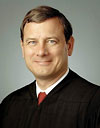Chief Justice of the United States

- Afghanistan
- Africa
- Budget Management
- Defense
- Economy
- Education
- Energy
- Environment
- Global Diplomacy
- Health Care
- Homeland Security
- Immigration
- International Trade
- Iraq
- Judicial Nominations
- Middle East
- National Security
- Veterans
- President's Cabinet
- USA Freedom Corps
- Faith-Based & Community Initiatives
- Office of Management and Budget
- National Security Council
- USA.gov
|
Home >
News & Policies >
Policies in Focus
|

On September 29, 2005, John G. Roberts, Jr. was confirmed as Chief Justice of the United States.
BIOGRAPHY
John G. Roberts, Jr., was born in Buffalo, New York, on January 27, 1955.
He grew up in Indiana, where he captained his high school football team and worked summers in a steel mill to help pay his way through college.
In 1976, he received his bachelor's degree from Harvard, summa cum laude , after only three years.
He then attended Harvard Law School, where he was managing editor of the Harvard Law Review and graduated magna cum laude in 1979.
The year after he graduated from law school, Roberts clerked for Justice Henry J. Friendly of the U.S. Court of Appeals for the Second Circuit.
- Friendly is acclaimed as the preeminent appellate judge of his generation. Chief Justice Warren Burger said of Justice Friendly that he could not identify “any judicial colleague more highly qualified to have come to the Supreme Court of the United States than Henry Friendly.” (Jeffrey B. Morris, Federal Justice in the Second Circuit 178 (1987).)
From 1980 to 1981, Chief Justice Roberts clerked for then-Associate Justice William H. Rehnquist on the United States Supreme Court.
Chief Justice Roberts then served as Special Assistant to Attorney General William French Smith from 1981 to 1982.
- In that role, he advised the Attorney General, wrote speeches, and acted as the Attorney General's representative to other officials in the Executive Branch and state and local governments.
From 1982 until 1986, Chief Justice Roberts served in the White House as Associate Counsel to President Ronald Reagan.
- His duties in the White House included reviewing bills submitted to the President by the Congress, drafting and reviewing Executive Orders, and generally reviewing the full range of presidential activities for legal problems.
In 1986, Chief Justice Roberts left the White House to enter private practice as an associate at the law firm of Hogan & Hartson. He was elected a partner a year later. His practice focused on appellate litigation and was by all accounts extremely successful.
- In 1989, Chief Justice Roberts argued his first case before the United States Supreme Court as court-appointed counsel in United States v. Halper , 490 U.S. 435 (1989), a double-jeopardy case. He prevailed on behalf of his client.
From 1989 until 1993, Chief Justice Roberts served as Principal Deputy Solicitor General, the second-in-command in the Office of the Solicitor General.
- As Principal Deputy Solicitor General, Chief Justice Roberts briefed and argued a variety of cases before the United States Supreme Court on behalf of the U.S. government.
In 1992, when Chief Justice Roberts was 37, President George H.W. Bush nominated him to the U.S. Court of Appeals for the D.C. Circuit. The nomination languished without action by the Senate.
In January 1993, Justice Roberts returned to Hogan & Hartson and resumed his appellate practice.
Including his tenure as a government lawyer, Chief Justice Roberts argued 39 cases before the United States Supreme Court, placing him among the country's most experienced Supreme Court litigators.
- Chief Justice Roberts' Supreme Court arguments alone span a vast set of issues within the Supreme Court's jurisdiction, including admiralty, antitrust, arbitration, environmental law, free speech/religion, health care law, Indian law, bankruptcy, tax, regulation of financial institutions, administrative law, labor law, federal jurisdiction and procedure, interstate commerce, civil rights, and criminal law.
- In addition to representing business interests, Chief Justice Roberts at different times represented the States of Hawaii, Alaska, and Nevada in defending diverse state social, health-and-welfare, and environmental policies before the United States Supreme Court.
- He was retained by the various state attorneys general pursuing antitrust claims against Microsoft to defend the district court's remedial orders before the D.C. Circuit.
- From time to time he also represented criminal defendants and indigents on a pro bono basis.
Chief Justice Roberts, a member of the D.C. Bar, is also admitted to practice before the United States Supreme Court. As an attorney, he was widely involved in bar activities:
- For example, he was a member of the United States Judicial Conference Advisory Committee on Appellate Rules, the American Law Institute, the American Academy of Appellate Lawyers, and the Legal Advisory Board of the National Legal Center for the Public Interest.
- He worked on the bipartisan Joint Project on the Independent Counsel Statute sponsored by the American Enterprise Institute and the Brookings Institution.
In May 2001, President George W. Bush nominated Roberts for a seat on the D.C. Circuit. His nomination was favorably reported by the Senate Judiciary Committee by a vote of 16-3. The Senate confirmed his nomination by unanimous consent on May 8, 2003.
On September 29, 2005, then-Judge Roberts was confirmed by the U.S. Senate and, after remarks by President George W. Bush, was sworn-in as the 17th Chief Justice of the United States by Associate Supreme Court Justice John Paul Stevens, in the East Room of the White House.
Chief Justice Roberts lives in Bethesda, Maryland, with his wife, Jane, and their two children, Josie and Jack. Jane Sullivan Roberts is a partner at Shaw Pittman in Washington, D.C. She has a background in technology law and currently heads the firm's professional development program. She has practiced in the private sector as a litigator and transactional lawyer throughout her legal career, including a year in Australia.



 September 29, 2005
September 29, 2005 September 5, 2005
September 5, 2005 July 19, 2005
July 19, 2005